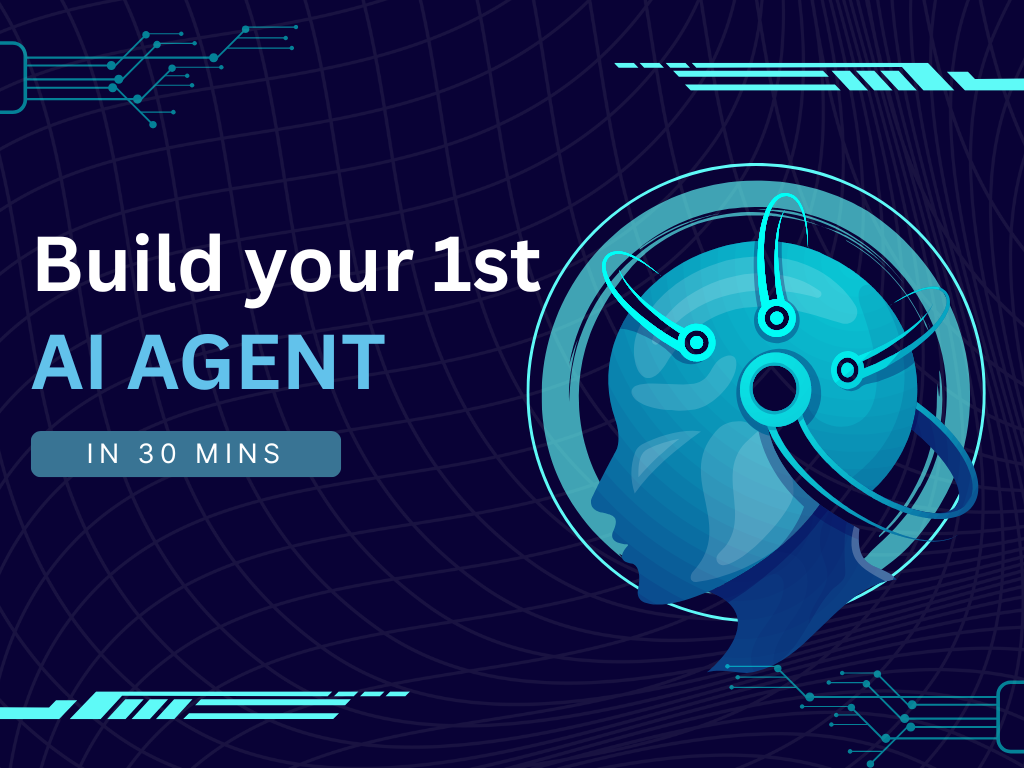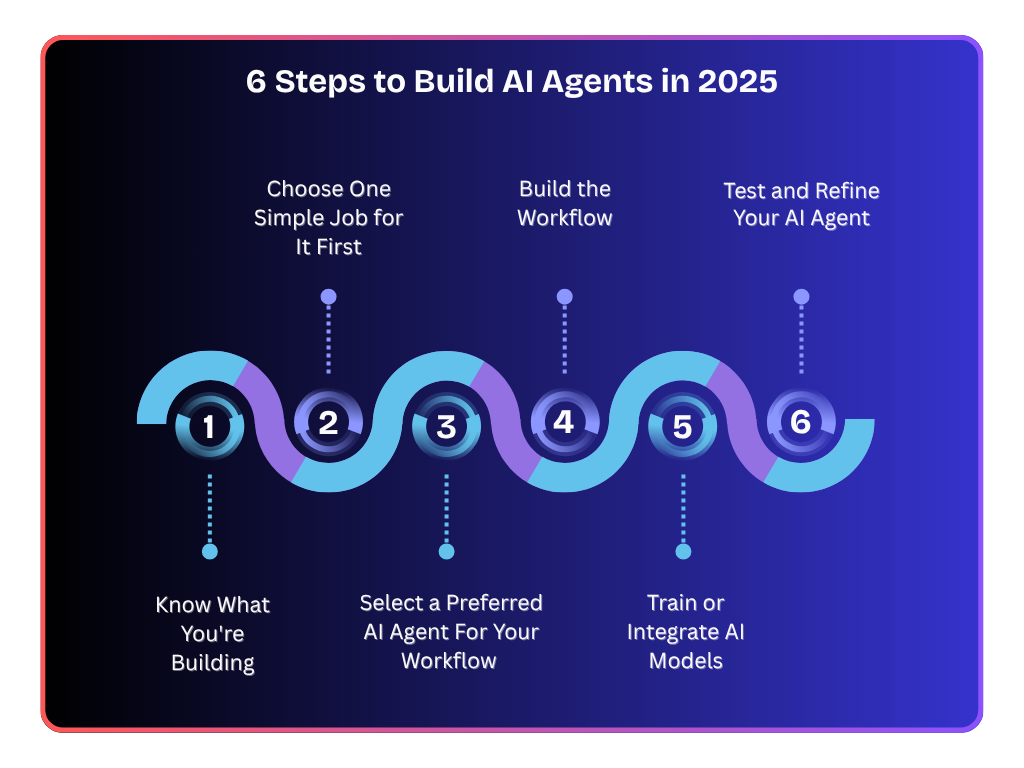
How to Build AI Agents in Under 30 Minutes (No Tech Jargon)

You’re drowning in repetitive tasks. Your team spends hours on data entry, customer inquiries, and report generation—work that could be automated. Meanwhile, your competitors are already leveraging AI agents to scale operations and cut costs by 40%.
The good news? You don’t need a computer science degree or a six-figure AI budget to build your first AI agent. In the next 30 minutes, you’ll have a working AI agent handling real business tasks. All you need is a basic understanding of AI agents to get started.
What Is an AI Agent? (The Simple Answer)
We describe an AI agent as software that acts independently to complete tasks on your behalf. Think of it as a digital employee that never sleeps, never calls in sick, and follows instructions perfectly every time.
Unlike basic chatbots that respond to questions, AI agents take action. They can:
- Read and analyze documents
- Make decisions based on data
- Execute tasks across multiple systems
- Learn from interactions to improve performance
These abilities are built on several key concepts, such as autonomy, data processing, and adaptive learning, which underpin how AI agents operate.
Real Example: Instead of manually reviewing 100 customer support tickets daily, an AI agent can categorize them, draft responses, and escalate complex issues to human agents—reducing response time from hours to minutes.
What Can AI Agents Do for Your Business?
AI agents excel at automating workflows that currently eat up your team's valuable time:
Customer Service Operations
- Instantly respond to common inquiries
- Route tickets to appropriate departments
- Generate personalized follow-up emails
- Update CRM records automatically
Data Processing & Analysis
- Extract information from invoices, contracts, and forms
- Generate weekly/monthly reports
- Monitor KPIs and alert stakeholders
- Cleanse and organize databases
Sales & Marketing
- Qualify leads from multiple sources
- Schedule meetings and send reminders
- Personalize email campaigns
- Track competitor pricing changes
HR & Operations
- Screen resumes and schedule interviews
- Onboard new employees with personalized workflows
- Manage expense approvals
- Monitor compliance requirements
The key insight: AI agents handle the "busy work" so your team can focus on strategy, creativity, and relationship-building.
Tool Definitions and Resources
When building effective AI agents, tool definitions are the foundation that enables your agent to actually get things done. Think of tools as the set of functions or resources your agent can use to perform specific tasks—like a digital toolbox.
For example, a calculator tool lets your agent safely solve math problems by evaluating user input, while a knowledge base tool helps the agent provide relevant information about topics such as artificial intelligence, programming languages, or your company’s products.
Defining these tools clearly gives your AI agent the context it needs to handle complex tasks. For instance, you might create a tool that pulls data from a spreadsheet, or one that sends emails based on user requests.
By integrating these tools into your agent’s workflow, you empower it to respond intelligently to a wide range of user inputs and scenarios.
For developers, creating and organizing tool definitions is a key step in building AI agents that are both powerful and reliable.
The right set of tools ensures your agent can access the data and functions it needs to deliver value—whether it’s answering questions, automating processes, or connecting with other systems.
How to Build AI Agents: Your 30-Minute Blueprint

Step 1: Choose Your Enterprise AI Platform (5 minutes)
Ampcome offers a conversational code platform for businesses to build AI agents that seamlessly integrate into workflows, excel at managing intricate tasks, and redefine productivity through adaptability, reasoning, and collaboration.
Here's what makes Ampcome's approach different from basic automation tools:
- Pre-built templates - Train and build agents within minutes using their conversational code AI agent development platform
- 100+ integrations with your favorite SaaS apps including Salesforce, ServiceNow, HubSpot and more
- Advanced AI technologies - Built using AutoGen's Multimodal Conversable Agent and LLaVA Agent for processing multi-sensory data
- Enterprise deployment - Deploy across AWS, Azure, GCP, within your VPC, or on-premise with PII data masking and encryption
- Custom training - Agents are specially curated on your business datasets giving them immense knowledge
Get Started: Visit Ampcome.com to explore their enterprise AI agent development services.
Step 2: Define Your Agent's Purpose (5 minutes)
Start with high-impact processes where you need to optimize, streamline or automate tasks while keeping you in full control of operations.
Proven Agent Use Cases from Ampcome:
- Customer Data Management - Centralize and update customer profiles in real-time for sales, marketing, and support teams
- Order Management - Automatically process incoming orders, update inventory in real-time, and confirm shipments
- Lead Generation & Qualification - Find high-value prospects, analyze customer data, and prioritize promising opportunities
- Risk Assessment - Scan transactions and vendor activities to detect anomalies and prevent losses
Define Your Agent's Scope:
- What specific business process needs automation?
- Which data sources will the agent access?
- What autonomous decisions should it make?
- When should human oversight be required?
Step 3: Set Up Data Connections (10 minutes)
Ampcome seamlessly connects your enterprise AI agents with 100+ tools and software through their integration ecosystem:
- Connect your systems using pre-built integrations for major business applications
- Configure permissions with role-based access controls and security protocols
- Map data relationships between different platforms and databases
- Validate connections in a secure testing environment
Enterprise Security: Built-in PII data masking and encryption techniques protect sensitive information automatically.
Step 4: Create Your Agent Logic (8 minutes)
Using Ampcome's conversational code approach, you can easily teach, train, and customize AI agents tailored to your business data and needs.
How It Works:
- Transform workflows into step-by-step instructions for AI agents to follow
- Equip agents with tools enabling them to perform tasks like Google search, transcribing, and more
- Leverage advanced algorithms that excel in analyzing intricate datasets, deriving insights, and executing measures
Example Agent Configuration: "Monitor customer support emails, categorize by urgency and department using natural language processing, automatically route billing issues to finance with high priority, escalate technical problems to support with relevant documentation, and send acknowledgment responses to customers within 2 minutes."
Step 5: Test and Deploy (2 minutes)
Ampcome provides built-in testing and monitoring capabilities to track and optimize AI operations instantly with regular assessments and continuous evaluations.
Pre-Launch Checklist:
- Run simulations with historical business data
- Test integrations across all connected systems
- Verify decision logic against business rules
- Monitor performance with real-time analytics
Expected Results: Businesses typically see 30% reduction in administrative workloads, 90% increase in customer satisfaction rates, and 40% time savings.
Ready to transform your operations? Contact Ampcome to discuss your specific AI agent requirements and see their proven results across enterprise clients.
Natural Language Processing: Making Your Agent Understand You
One of the most exciting aspects of building AI agents is their ability to understand and communicate in natural language—just like a human.
This is made possible by Natural Language Processing (NLP), a branch of artificial intelligence focused on helping agents process, interpret, and generate human language.
With NLP, your AI agent can comprehend user queries, no matter how they’re phrased.
Techniques like tokenization (breaking sentences into words), named entity recognition (identifying names, dates, or places), and sentiment analysis (detecting emotions) allow your agent to grasp the meaning and intent behind user input.
This means users can interact with your agent using everyday language, making the experience more intuitive and accessible.
Developers can also fine-tune the agent’s language capabilities, ensuring it responds in a way that feels natural and helpful.
By leveraging NLP, you can build AI agents that not only understand what users are asking, but also provide clear, accurate, and human-like responses—making your agent a true digital assistant.
Fine-Tuning Your AI Agent for Better Results
To get the most out of your AI agent, it’s important to fine-tune its performance for your specific target audience and use cases. Fine-tuning means adjusting the agent’s parameters and training data so it better understands user input, selects the right tools, and delivers more accurate responses.
This process often involves learning from real user feedback—analyzing where the agent excels and where it might make errors.
Developers can use techniques like active learning (where the agent learns from new data), transfer learning (adapting knowledge from similar tasks), and reinforcement learning (improving through trial and error) to continually improve the agent’s capabilities.
By fine-tuning your AI agent, you reduce mistakes, enhance the user experience, and ensure the agent remains aligned with your business goals. Regularly updating the agent based on feedback and new data helps it stay relevant and effective as your needs evolve.
AI Solution Integration
To unlock the full potential of your AI agent, integration with other systems and tools is key. AI solution integration means connecting your agent with databases, APIs, and software applications your business already uses.
This allows your agent to access up-to-date information, automate more complex tasks, and provide a seamless experience for users.
For example, integrating your AI agent with a CRM system enables it to deliver personalized customer support, while connecting it to a knowledge base allows it to answer user questions with relevant information instantly.
Developers can also link agents to project management tools, email platforms, or analytics dashboards, creating workflows that save time and reduce manual effort.
By building integrated AI agents, you create a unified system where tasks are handled efficiently, data flows smoothly, and users get the support they need—no matter where they interact with your business.
Real-World Success Stories
Case Study 1: E-commerce Company
- Challenge: Processing 500+ customer returns daily
- Solution: AI agent reads return requests, checks order history, auto-approves eligible returns
- Result: 78% reduction in processing time, 95% customer satisfaction score
Case Study 2: Professional Services Firm
- Challenge: Manual expense report approvals taking 3-5 days
- Solution: AI agent validates receipts, checks policy compliance, routes for approval
- Result: Average approval time reduced to 4 hours, 60% fewer policy violations
Case Study 3: SaaS Startup
- Challenge: Lead qualification consuming 15 hours weekly
- Solution: AI agent scores inbound leads, enriches data, schedules demos for qualified prospects
- Result: 240% increase in sales team productivity, 45% higher conversion rate
Advanced AI Agent Capabilities (What's Possible)
Once you've mastered basic agents, you can build more sophisticated workflows:
Multi-Step Decision Trees Agents that handle complex scenarios with multiple decision points and escalation paths.
Cross-Platform Integration Agents that work across your entire tech stack, from CRM to accounting software to communication tools.
Learning and Adaptation Agents that improve performance based on feedback and historical data patterns.
Natural Language Processing Agents that understand context, sentiment, and intent in customer communications.
Common Pitfalls (And How to Avoid Them)
Starting Too Complex Build simple agents first. Master the basics before attempting multi-step workflows.
Insufficient Testing Always test with real data in a safe environment before full deployment.
Poor Error Handling Define what happens when things go wrong. Build in human oversight for edge cases.
Ignoring User Adoption Train your team on how to work with AI agents. Change management is crucial for success.
Measuring AI Agent Success
Track these metrics to prove ROI:
Efficiency Metrics
- Time saved per task
- Volume of tasks automated
- Error rate reduction
- Employee satisfaction scores
Business Impact
- Cost per transaction
- Customer response times
- Revenue per employee
- Process completion rates
Example ROI Calculation:
- Task: Invoice processing
- Manual time: 15 minutes per invoice
- Agent time: 2 minutes per invoice
- Monthly volume: 1,000 invoices
- Monthly savings: 217 hours ($6,500 at $30/hour)
- Annual ROI: $78,000
AI Agent Maintenance and Updates
Building your AI agent is just the beginning—ongoing maintenance and updates are essential to keep it performing at its best. Regularly updating your agent’s training data, fine-tuning its parameters, and monitoring its performance ensures it stays accurate, relevant, and effective for users.
Developers should use tools like data versioning to track changes, model monitoring to catch errors or performance drops, and continuous integration to roll out improvements smoothly.
By keeping a close eye on how your agent is responding to user input and handling tasks, you can quickly identify and fix any issues, address biases, and adapt to new business needs.
Prioritizing maintenance and updates means your AI agent will continue to deliver value over time—helping users, automating tasks, and supporting your business as it grows and evolves.
Security and Compliance Considerations
Data Protection
- Encrypt all data in transit and at rest
- Use role-based access controls
- Regular security audits and updates
- Compliance with GDPR, HIPAA, SOC 2 as required
Human Oversight
- Define escalation triggers for complex scenarios
- Regular review of agent decisions
- Audit trails for all automated actions
- Easy manual override capabilities
What's Next: Scaling Your AI Agent Strategy
Once your first agent proves successful:
Month 2-3: Expand Use Cases Identify 3-5 additional processes for automation based on initial success.
Month 4-6: Advanced Integration Connect agents across departments for end-to-end workflow automation.
Month 7-12: Strategic Transformation Use AI agents to enable new business models and competitive advantages.
Consider Professional Implementation For enterprise-scale deployments, partner with AI automation specialists who can ensure proper architecture, security, and change management.
Your 30-Day Action Plan
Week 1: Build your first simple agent following this guide
Week 2: Monitor performance and gather team feedback
Week 3: Optimize based on real-world usage patterns
Week 4: Plan your next 2-3 automation projects
Conclusion: The Future is Automated (And It Starts Today)
AI agents aren't coming—they're here. While your competitors debate the technology, you can be implementing solutions that deliver immediate business value.
The 30 minutes you invest today in building your first AI agent will pay dividends for years. You'll reduce costs, improve accuracy, and free your team to work on high-value activities that drive growth.
Remember: You don't need to revolutionize your entire business overnight. Start with one process, prove the value, then scale systematically.
The question isn't whether AI agents will transform your industry—it's whether you'll lead that transformation or scramble to catch up.
Ready to build your first AI agent? The tools are available, the process is straightforward, and your competition is waiting. Don't give them that advantage.

Transform Your Business With Agentic Automation
Agentic automation is the rising star posied to overtake RPA and bring about a new wave of intelligent automation. Explore the core concepts of agentic automation, how it works, real-life examples and strategies for a successful implementation in this ebook.
More insights
Discover the latest trends, best practices, and expert opinions that can reshape your perspective
Contact us







.png)



